Implementation of Robust Satellite Techniques for Volcanoes on ASTER Data under the Google Earth Engine Platform
Abstract
Featured Application
Abstract
1. Introduction
2. Materials and Methods
2.1. Advanced Spaceborne Thermal Emission and Reflection Radiometer (ASTER)
2.2. Robust Satellite Techniques (RST)
2.3. Robust ASTER Thermal Anomaly System (RASTer)
2.4. The AVA Database
3. Results
3.1. Etna Volcano
3.2. Shishaldin Volcano
3.3. Shinmoedake Volcano
4. Discussion
5. Conclusions
Author Contributions
Funding
Institutional Review Board Statement
Informed Consent Statement
Data Availability Statement
Conflicts of Interest
References
- Dehn, J.; Dean, K.; Engle, K. Thermal monitoring of North Pacific volcanoes from space. Geology 2000, 28, 755–758. [Google Scholar] [CrossRef]
- Pergola, N.; Marchese, F.; Tramutoli, V. Automated detection of thermal features of active volcanoes by means of infrared AVHRR records. Remote Sens. Environ. 2004, 93, 311–327. [Google Scholar] [CrossRef]
- Coppola, D.; Laiolo, M.; Cigolini, C. Fifteen years of thermal activity at Vanuatu’s volcanoes (2000–2015) revealed by MIROVA. J. Volcanol. Geotherm. Res. 2016, 322, 6–19. [Google Scholar] [CrossRef]
- Marchese, F.; Neri, M.; Falconieri, A.; Lacava, T.; Mazzeo, G.; Pergola, N.; Tramutoli, V. The Contribution of Multi-Sensor Infrared Satellite Observations to Monitor Mt. Etna (Italy) Activity during May to August 2016. Remote Sens. 2018, 10, 1948. [Google Scholar] [CrossRef]
- Wright, R.; Pilger, E. Radiant flux from Earth’s subaerially erupting volcanoes. Int. J. Remote Sens. 2008, 29, 6443–6466. [Google Scholar] [CrossRef]
- Mastin, L.G. Testing the accuracy of a 1-D volcanic plume model in estimating mass eruption rate. J. Geophys. Res. Atmos. 2014, 119, 2474–2495. [Google Scholar] [CrossRef]
- Connor, C.B.; Clement, B.M.; Song, X.; Lane, S.B.; West-Thomas, J. Continuous monitoring of high-temperature fumaroles on an active lava dome, Volcán Colima, Mexico: Evidence of mass flow variation in response to atmospheric forcing. J. Geophys. Res. Space Phys. 1993, 98, 19713–19722. [Google Scholar] [CrossRef]
- Wright, R.; Flynn, L.; Garbeil, H.; Harris, A.; Pilger, E. Automated volcanic eruption detection using MODIS. Remote Sens. Environ. 2002, 82, 135–155. [Google Scholar] [CrossRef]
- Wright, R.; Flynn, L.P.; Garbeil, H.; Harris, A.J.; Pilger, E. MODVOLC: Near-real-time thermal monitoring of global volcanism. J. Volcanol. Geotherm. Res. 2004, 135, 29–49. [Google Scholar] [CrossRef]
- Coppola, D.; Laiolo, M.; Cigolini, C.; Massimetti, F.; Donne, D.D.; Ripepe, M.; Arias, H.; Barsotti, S.; Parra, C.B.; Centeno, R.G.; et al. Thermal Remote Sensing for Global Volcano Monitoring: Experiences from the MIROVA System. Front. Earth Sci. 2020, 7. [Google Scholar] [CrossRef]
- Kervyn, M.; Ernst, G.G.J.; Harris, A.J.L.; Belton, F.; Mbede, E.; Jacobs, P. Thermal remote sensing of the low-intensity carbonatite volcanism of Oldoinyo Lengai, Tanzania. Int. J. Remot. Sens. 2008, 29, 6467–6499. [Google Scholar] [CrossRef]
- Marchese, F.; Filizzola, C.; Genzano, N.; Mazzeo, G.; Pergola, N.; Tramutoli, V. Assessment and improvement of a robust satellite technique (RST) for thermal monitoring of volcanoes. Remote Sens. Environ. 2011, 115, 1556–1563. [Google Scholar] [CrossRef]
- Lacava, T.; Marchese, F.; Pergola, N.; Tramutoli, V.; Coviello, I.; Faruolo, M.; Paciello, R.; Mazzeo, G. RSTVOLC implementa-tion on MODIS data for monitoring of thermal volcanic activity. Ann. Geophys. 2011, 54, 536–542. [Google Scholar] [CrossRef]
- Pergola, N.; Coviello, I.; Filizzola, C.; Lacava, T.; Marchese, F.; Paciello, R.; Tramutoli, V. A review of RSTVOLC, an original algorithm for automatic detection and near-real-time monitoring of volcanic hotspots from space. Geol. Soc. Lond. Spec. Publ. 2015, 426, 55–72. [Google Scholar] [CrossRef]
- Plank, S.; Marchese, F.; Filizzola, C.; Pergola, N.; Neri, M.; Nolde, M.; Martinis, S. The July/August 2019 Lava Flows at the Sciara del Fuoco, Stromboli–Analysis from Multi-Sensor Infrared Satellite Imagery. Remote Sens. 2019, 11, 2879. [Google Scholar] [CrossRef]
- Marchese, F.; Lacava, T.; Pergola, N.; Hattori, K.; Miraglia, E.; Tramutoli, V. Inferring phases of thermal unrest at Mt. Asama (Japan) from infrared satellite observations. J. Volcanol. Geotherm. Res. 2012, 237–238, 10–18. [Google Scholar] [CrossRef]
- Ramsey, M.S. Synergistic use of satellite thermal detection and science: A decadal perspective using ASTER. Geol. Soc. Lond. Spec. Publ. 2015, 426, 115–136. [Google Scholar] [CrossRef]
- Ramsey, M.; Flynn, I. The Spatial and Spectral Resolution of ASTER Infrared Image Data: A Paradigm Shift in Volcanological Remote Sensing. Remote Sens. 2020, 12, 738. [Google Scholar] [CrossRef]
- Gorelick, N.; Hancher, M.; Dixon, M.; Ilyushchenko, S.; Thau, D.; Moore, R. Google Earth Engine: Planetary-scale geospatial analysis for everyone. Remote Sens. Environ. 2017, 202, 18–27. [Google Scholar] [CrossRef]
- Marchese, F.; Genzano, N.; Neri, M.; Falconieri, A.; Mazzeo, G.; Pergola, N. A Multi-Channel Algorithm for Mapping Volcanic Thermal Anomalies by Means of Sentinel-2 MSI and Landsat-8 OLI Data. Remote Sens. 2019, 11, 2876. [Google Scholar] [CrossRef]
- Genzano, N.; Pergola, N.; Marchese, F. A Google Earth Engine Tool to Investigate, Map and Monitor Volcanic Thermal Anomalies at Global Scale by Means of Mid-High Spatial Resolution Satellite Data. Remote Sens. 2020, 12, 3232. [Google Scholar] [CrossRef]
- Abrams, M.; Tsu, H.; Hulley, G.; Iwao, K.; Pieri, D.; Cudahy, T.; Kargel, J. The Advanced Spaceborne Thermal Emission and Reflection Radiometer (ASTER) after fifteen years: Review of global products. Int. J. Appl. Earth Obs. Geoinf. 2015, 38, 292–301. [Google Scholar] [CrossRef]
- LP DAAC Team. Advanced Spaceborne Thermal Emission and Reflection Radiometer (ASTER) Level 1 Precision Terrain Corrected Registered At-Sensor Radiance Product (AST_L1T). Available online: https://lpdaac.usgs.gov/documents/300/ASTER_L1T_Product_Specification.pdf (accessed on 2 April 2021).
- Tramutoli, V. Robust Satellite Techniques (RST) for Natural and Environmental Hazards Monitoring and Mitigation: Theory and Applications. In Proceedings of the IEEE Fourth International Workshop on the Analysis of Multitemporal Remote Sensing Images, Leuven, Belgium, 18–20 July 2007; pp. 1–6. [Google Scholar] [CrossRef]
- Tramutoli, V. Robust AVHRR Techniques (RAT) for Environmental Monitoring: Theory and applications. In Earth Surface Remote Sensing II; Cecchi, G., Zilioli, E., Eds.; SPIE: Barcelona, Spain, 1998; Volume 349, pp. 101–113. [Google Scholar] [CrossRef]
- Filizzola, C.; Corrado, R.; Marchese, F.; Mazzeo, G.; Paciello, R.; Pergola, N.; Tramutoli, V. RST-FIRES, an exportable algorithm for early-fire detection and monitoring: Description, implementation, and field validation in the case of the MSG-SEVIRI sensor. Remote Sens. Environ. 2017, 192, e2–e25. [Google Scholar] [CrossRef]
- Faruolo, M.; Lacava, T.; Pergola, N.; Tramutoli, V. On the Potential of the RST-FLARE Algorithm for Gas Flaring Characterization from Space. Sensors 2018, 18, 2466. [Google Scholar] [CrossRef]
- Filizzola, C.; Cerra, D.; Corrado, R.; De La Cruz, A.; Pergola, N.; Tramutoli, V. Robust Satellite Techniques (RST) for Pipeline Network Monitoring. In Proceedings of the IEEE Fourth International Workshop on the Analysis of Multitemporal Remote Sensing Images, Leuven, Belgium, 18–20 July 2007; pp. 1–5. [Google Scholar] [CrossRef]
- Pieri, D.; Abrams, M. ASTER watches the world’s volcanoes: A new paradigm for volcanological observations from orbit. J. Volcanol. Geotherm. Res. 2004, 135, 13–28. [Google Scholar] [CrossRef]
- Lacava, T.; Kervyn, M.; Liuzzi, M.; Marchese, F.; Pergola, N.; Tramutoli, V. Assessing performance of the RSTVOLC multi-temporal algorithm in detecting subtle hot spots at Oldoinyo Lengai (Tanzania, Africa) for comparison with MODLEN. Remote Sens. 2018, 10, 1177. [Google Scholar] [CrossRef]
- Branca, S.; Del Carlo, P. Types of eruptions of Etna volcano AD 1670–2003: Implications for short-term eruptive behaviour. Bull. Volcanol. 2005, 67, 732–742. [Google Scholar] [CrossRef]
- Behncke, B.; Neri, M. Cycles and trends in the recent eruptive behaviour of Mount Etna (Italy). Can. J. Earth Sci. 2003, 40, 1405–1411. [Google Scholar] [CrossRef]
- Acocella, V.; Neri, M.; Behncke, B.; Bonforte, A.; Del Negro, C.; Ganci, G. Why Does a Mature Volcano Need New Vents? The Case of the New Southeast Crater at Etna. Front. Earth Sci. 2016, 4, 67. [Google Scholar] [CrossRef]
- Behncke, B.; Branca, S.; Corsaro, R.A.; De Beni, E.; Miraglia, L.; Proietti, C. The 2011–2012 summit activity of Mount Etna: Birth, growth and products of the new SE crater. J. Volcanol. Geotherm. Res. 2014, 270, 10–21. [Google Scholar] [CrossRef]
- De Beni, E.; Behncke, B.; Branca, S.; Nicolosi, I.; Carluccio, R.; Caracciolo, F.D.; Chiappini, M. The continuing story of Etna’s New Southeast Crater (2012–2014): Evolution and volume calculations based on field surveys and aerophotogrammetry. J. Volcanol. Geotherm. Res. 2015, 303, 175–186. [Google Scholar] [CrossRef]
- Ganci, G.; Cappello, A.; Bilotta, G.; Hérault, A.; Zago, V.; Del Negro, C. Mapping Volcanic Deposits of the 2011–2015 Etna Eruptive Events Using Satellite Remote Sensing. Front. Earth Sci. 2018, 6. [Google Scholar] [CrossRef]
- Zuccarello, F.; Schiavi, F.; Viccaro, M. Magma dehydration controls the energy of recent eruptions at Mt. Etna volcano. Terra Nova 2021. [Google Scholar] [CrossRef]
- Neri, M.; Casu, F.; Acocella, V.; Solaro, G.; Pepe, S.; Berardino, P.; Sansosti, E.; Caltabiano, T.; Lundgren, P.; Lanari, R. Deformation and eruptions at Mt. Etna (Italy): A lesson from 15 years of observations. Geophys. Res. Lett. 2009, 36. [Google Scholar] [CrossRef]
- Neri, M.; Acocella, V.; Behncke, B.; Giammanco, S.; Mazzarini, F.; Rust, D. Structural analysis of the eruptive fissures at Mount Etna (Italy). Ann. Geophys. 2011, 54, 464–479. [Google Scholar] [CrossRef]
- Nye, C.; Keith, T.; Eichelberger, J.; Miller, T.; McNutt, S.; Moran, S.; Schneider, D.J.; Dehn, J.; Schaefer, J.R. The 1999 eruption of Shishaldin Volcano, Alaska: Monitoring a distant eruption. Bull. Volcanol. 2002, 64, 507–519. [Google Scholar] [CrossRef]
- Cameron, C.E.; Dixon, J.P.; Neal, C.A.; Waythomas, C.F.; Schaefer, J.R.; McGimsey, R.G. 2014 Volcanic Activity in Alaska—Summary of Events and Response of the Alaska Volcano Observatory; U.S. Geological Survey Scientific Investigations Report 2017–5077; U.S. Geological Survey: Anchorage, AK, USA, 2017; 81p. [CrossRef]
- Alaska Volcano Observatory. Shishaldin Reported Activity, Event Name: Shishaldin 2014/1. Available online: https://avo.alaska.edu/volcanoes/activity.php?volcname=Shishaldin&page=basic&eruptionid=771 (accessed on 2 April 2021).
- Global Volcanism Program. Bulletin of the Global Volcanism Network 45:2; Report on Shishaldin (United, States); Krippner, J.B., Venzke, E., Eds.; Smithsonian Institution: Washington, DC, USA, 2020. [Google Scholar]
- Lacava, T.; Marchese, F.; Arcomano, G.; Coviello, I.; Falconieri, A.; Faruolo, M.; Pergola, N.; Tramutoli, V. Thermal Monitoring of Eyjafjöll Volcano Eruptions by Means of Infrared MODIS Data. IEEE J. Sel. Top. Appl. Earth Obs. Remote Sens. 2014, 7, 3393–3401. [Google Scholar] [CrossRef]
- Kato, K.; Yamasato, H. The 2011 eruptive activity of Shinmoedake volcano, Kirishimayama, Kyushu, Japan—Overview of activity and Volcanic Alert Level of the Japan Meteorological Agency. Earth Planets Space 2013, 65, 489–504. [Google Scholar] [CrossRef]
- Global Volcanism Program. Bulletin of the Global Volcanism Network 35:12; Report on Kirishimayama (Japan); Wunderman, R., Ed.; Smithsonian Institution: Washington, DC, USA, 2010. [Google Scholar]
- Ozawa, T.; Kozono, T. Temporal variation of the Shinmoe-dake crater in the 2011 eruption revealed by spaceborne SAR ob-servations. Earth Planets Space 2013, 65, 527–537. [Google Scholar] [CrossRef]
- Global Volcanism Program. Bulletin of the Global Volcanism Network 43:6; Report on Kirishimayama, (Japan); Crafford, A.E., Venzke, E., Eds.; Smithsonian Institution: Washington, DC, USA, 2018. [Google Scholar] [CrossRef]
- Neri, M.; De Maio, M.; Crepaldi, S.; Suozzi, E.; Lavy, M.; Marchionatti, F.; Calvari, S.; Buongiorno, M.F. Topographic Maps of Mount Etna’s Summit Craters, updated to December 2015. J. Maps 2017, 13, 674–683. [Google Scholar] [CrossRef]
- De Beni, E.; Cantarero, M.; Neri, M.; Messina, A. Lava flows of Mt Etna, Italy: The 2019 eruption within the context of the last two decades (1999–2019). J. Maps 2020, 1–12. [Google Scholar] [CrossRef]
- Global Volcanism Program. Bulletin of the Global Volcanism Network 40:1; Report on Shishaldin (United States); Wunderman, R., Ed.; Smithsonian Institution: Washington, DC, USA, 2015. [Google Scholar] [CrossRef]
- Global Volcanism Program. Bulletin of the Global Volcanism Network 42:9; Report on Etna, (Italy); Crafford, A.E., Venzke, E., Eds.; Smithsonian Institution: Washington, DC, USA, 2017. [Google Scholar] [CrossRef]
- Marchese, F.; Falconieri, A.; Pergola, N.; Tramutoli, V. A retrospective analysis of the Shinmoedake (Japan) eruption of 26–27 January 2011 by means of Japanese geostationary satellite data. J. Volcanol. Geotherm. Res. 2014, 269, 1–13. [Google Scholar] [CrossRef]
- Mazzeo, G.; Ramsey, M.S.; Marchese, F.; Genzano, N.; Pergola, N. Implementation of the NHI (Normalized Hot Spot Indices). Algorithm on Infrared ASTER Data: Results and Future Perspectives. Sensors 2021, 21, 1538. [Google Scholar] [CrossRef] [PubMed]
- Reath, K.; Pritchard, M.E.; Moruzzi, S.; Alcott, A.; Coppola, D.; Pieri, D. The AVTOD (ASTER Volcanic Thermal Output Da-tabase) Latin America archive. J. Volcanol. Geotherm. Res. 2019, 376, 62–74. [Google Scholar] [CrossRef]
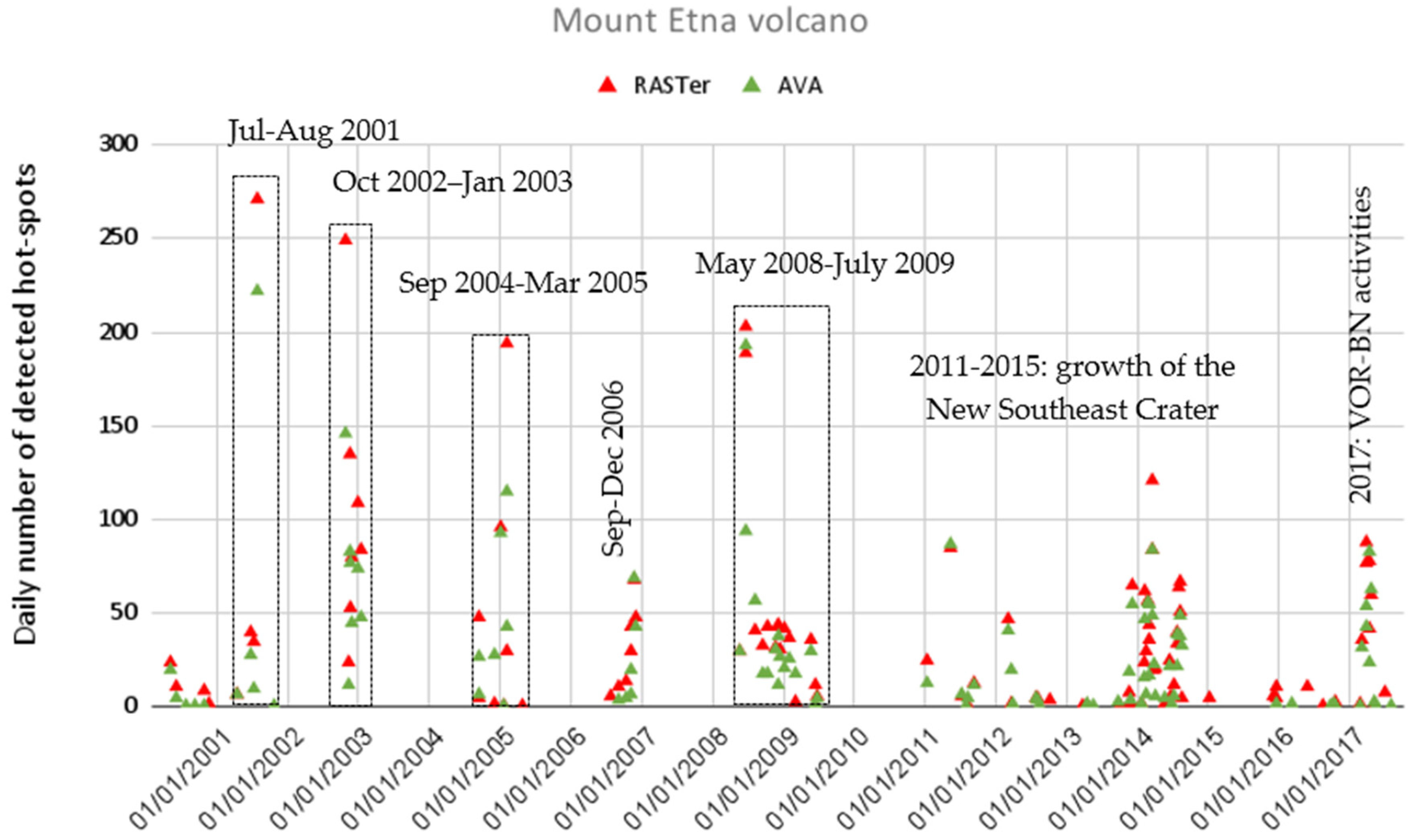

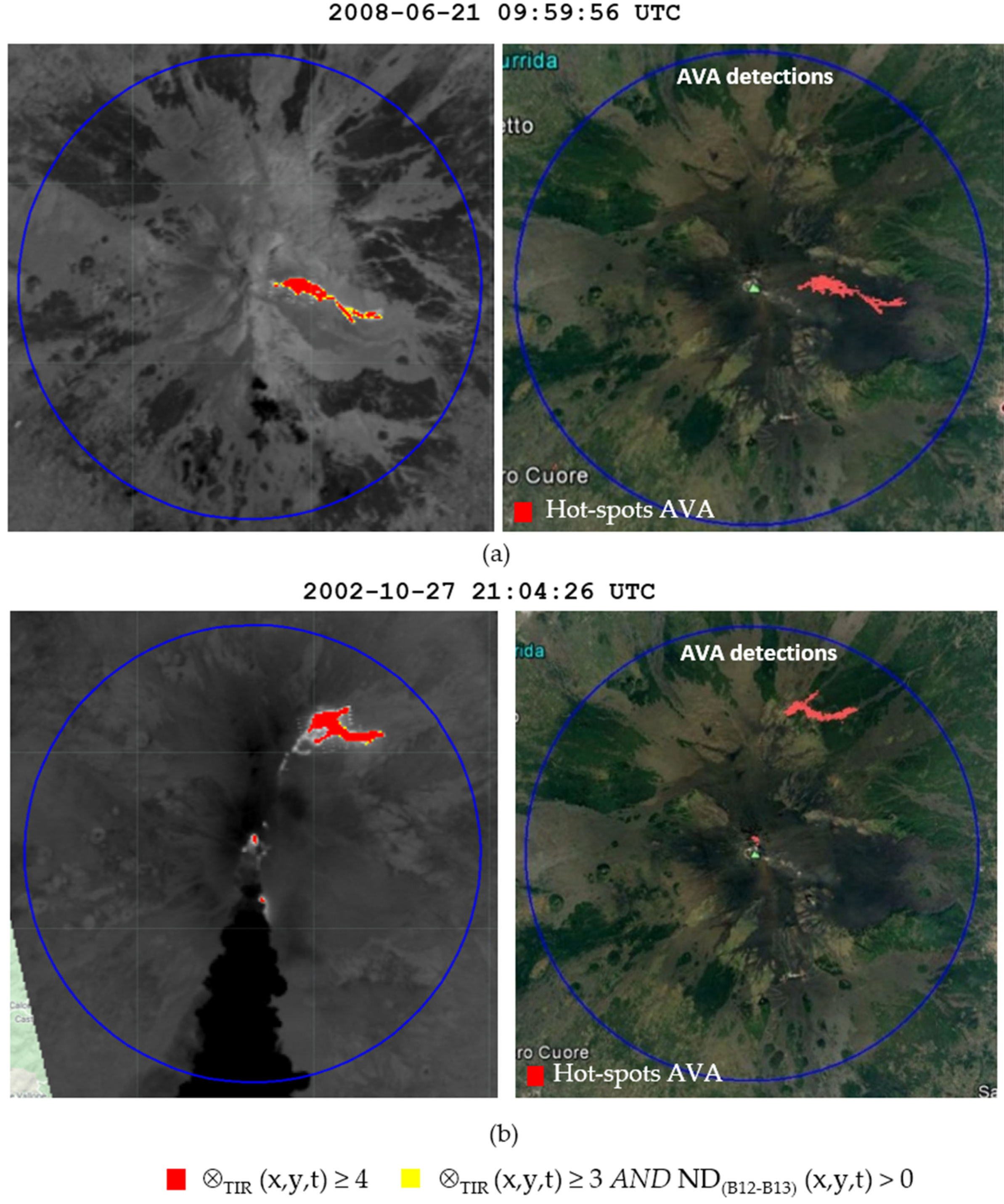
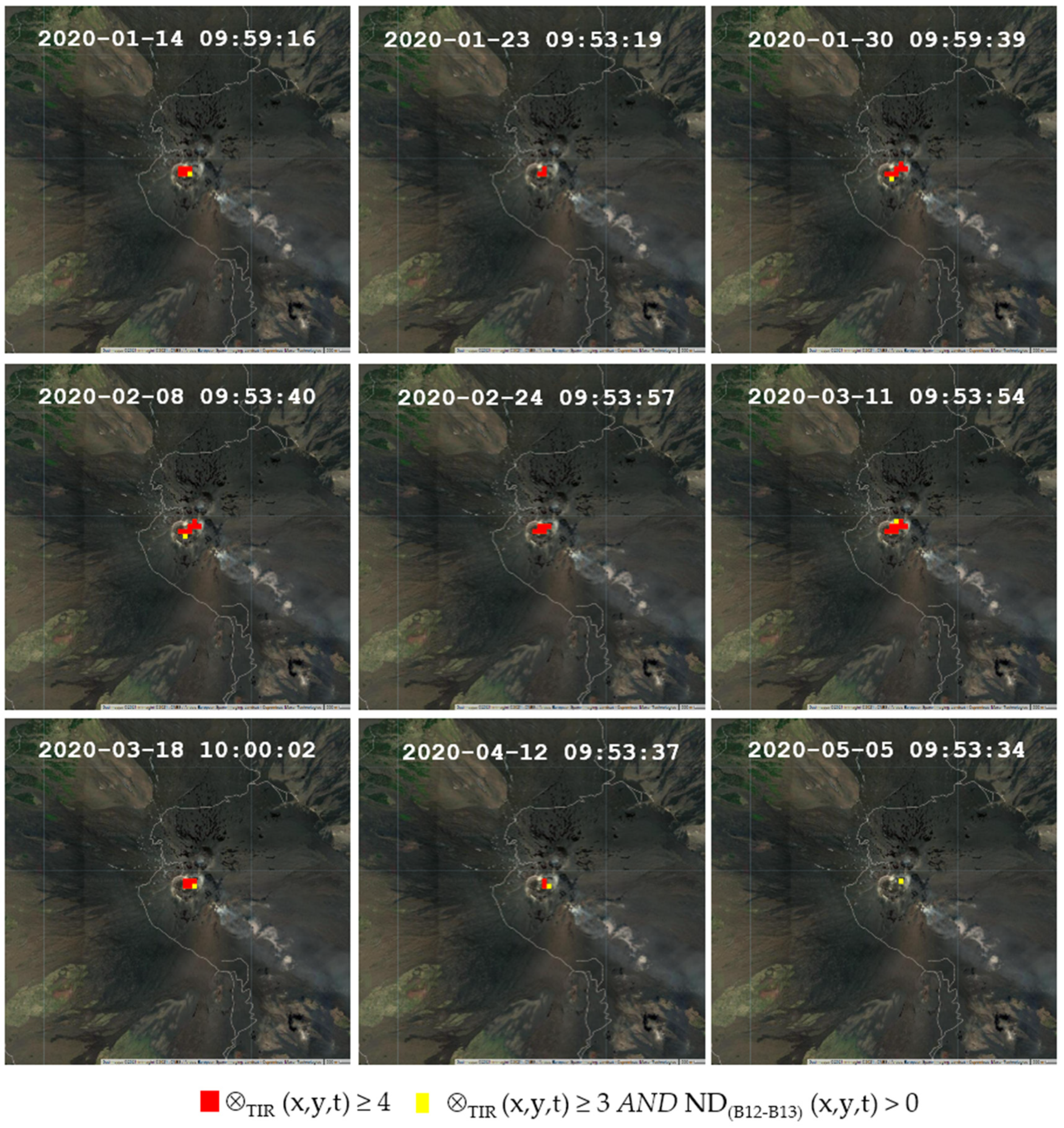
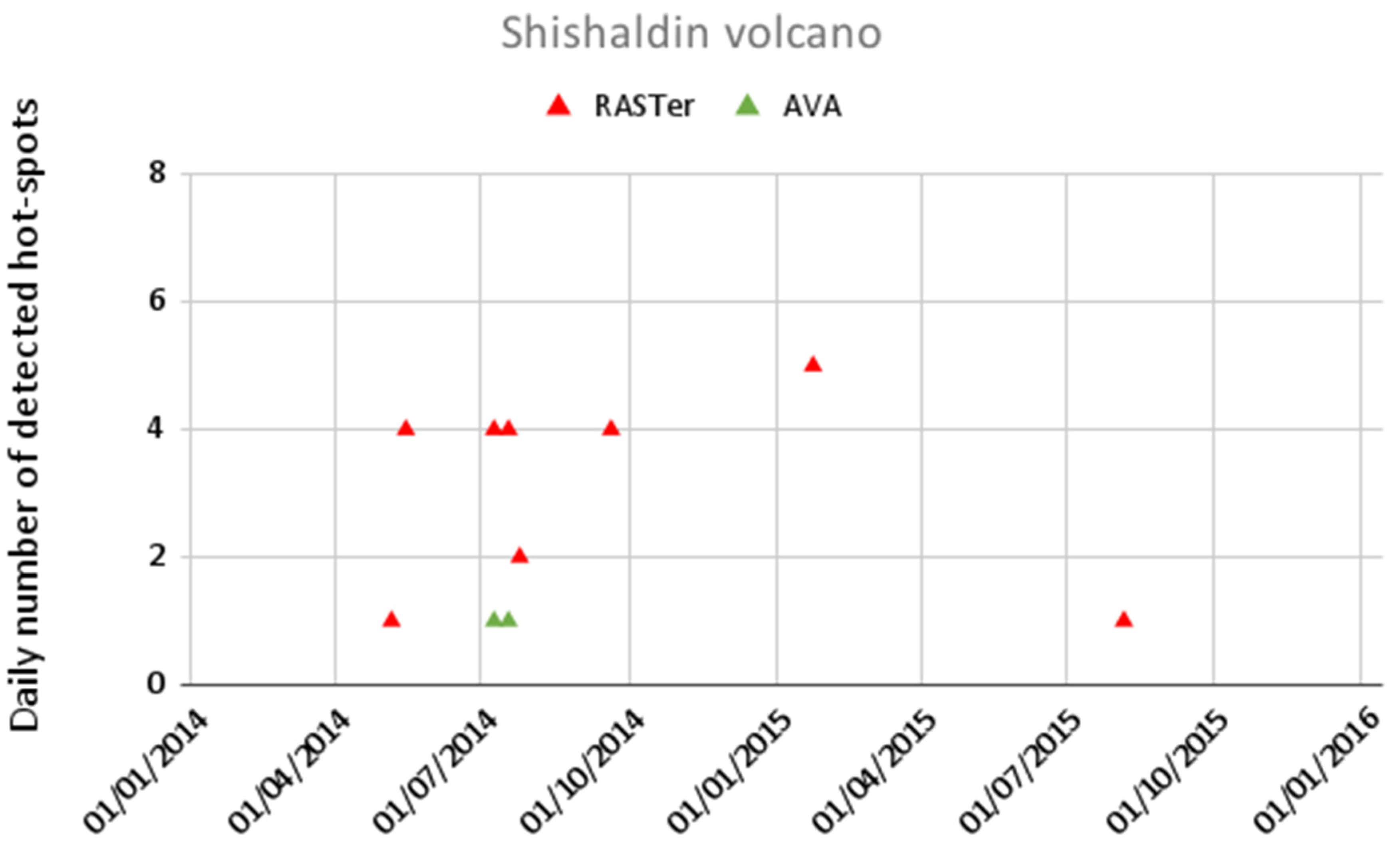
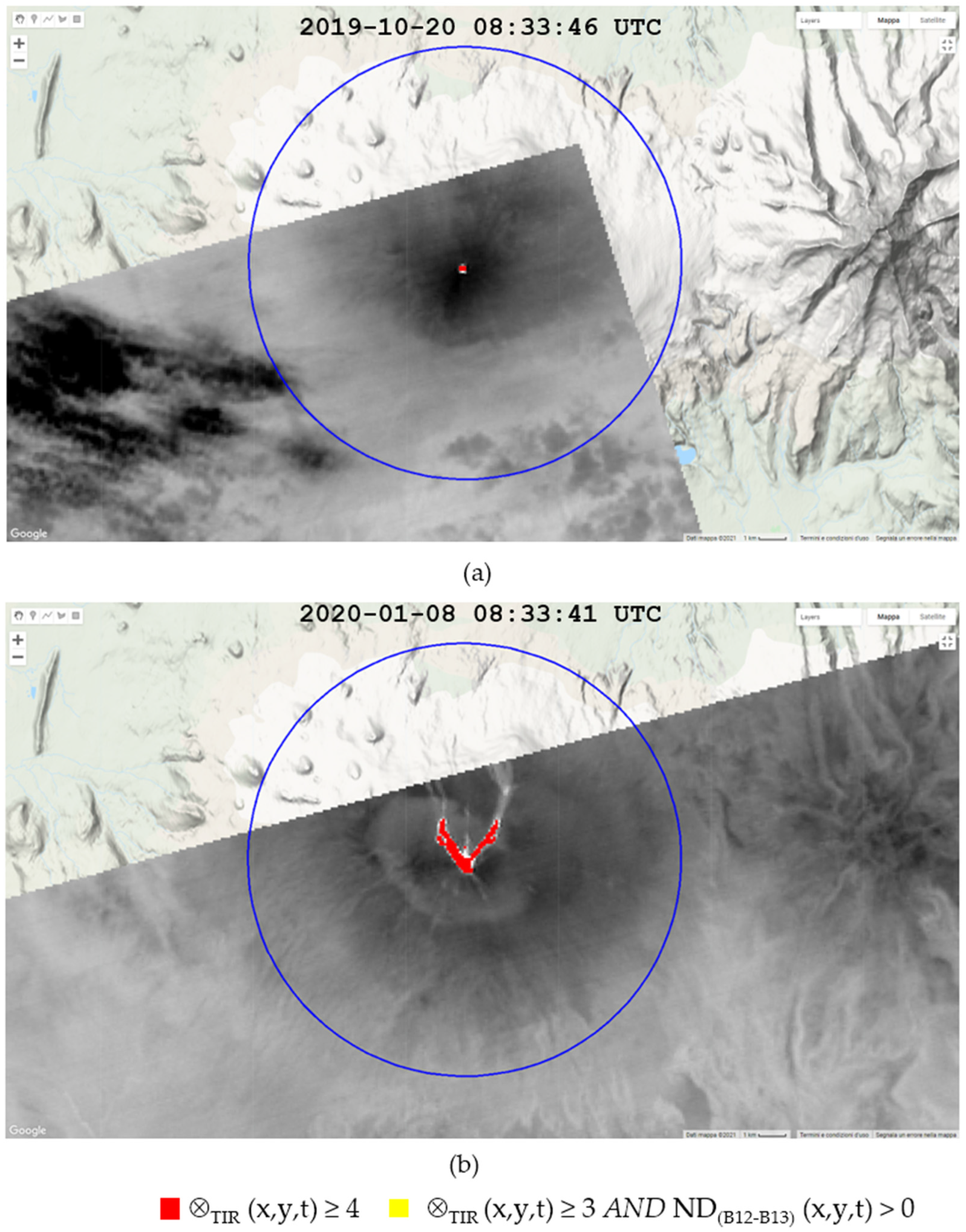
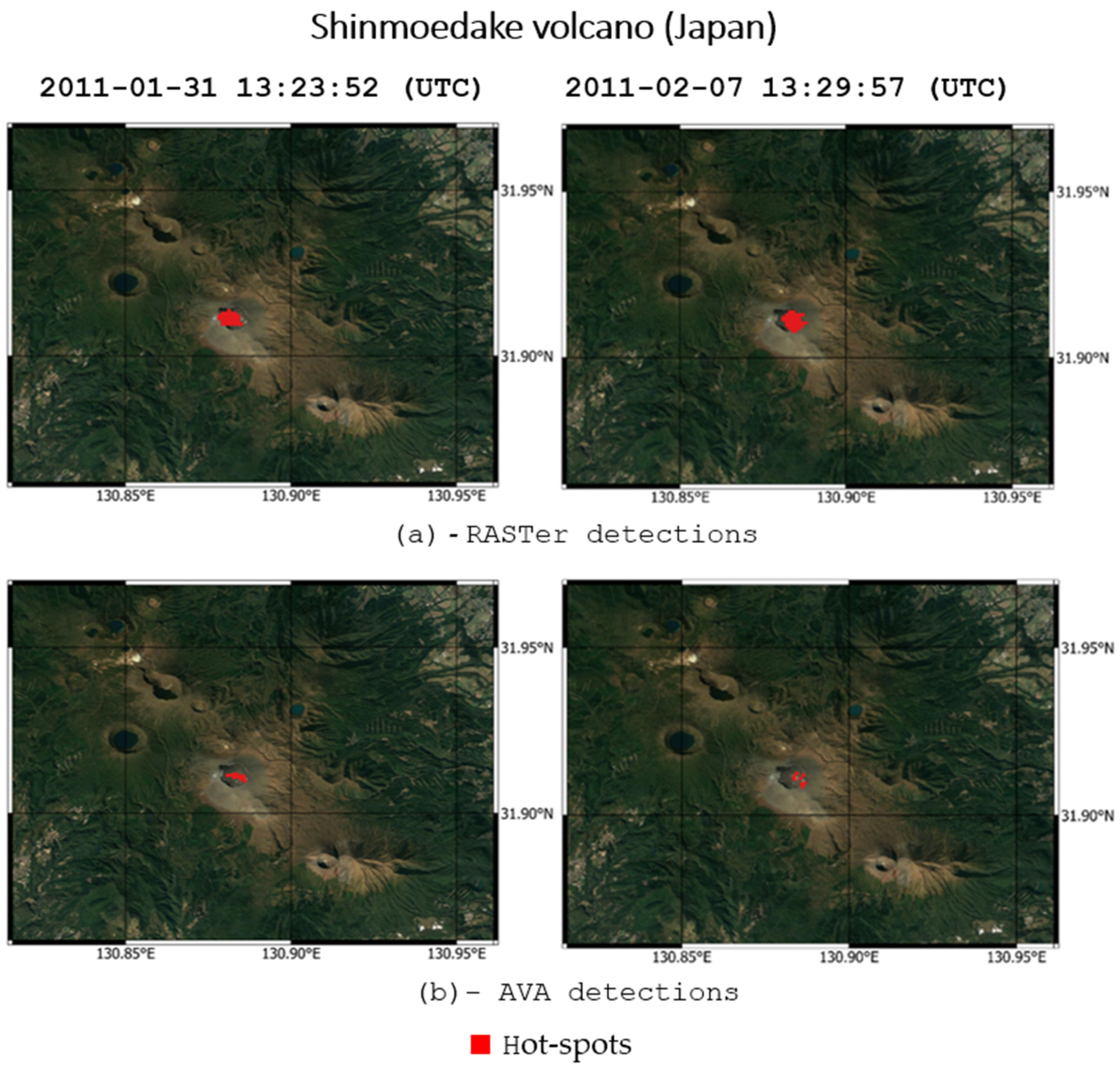
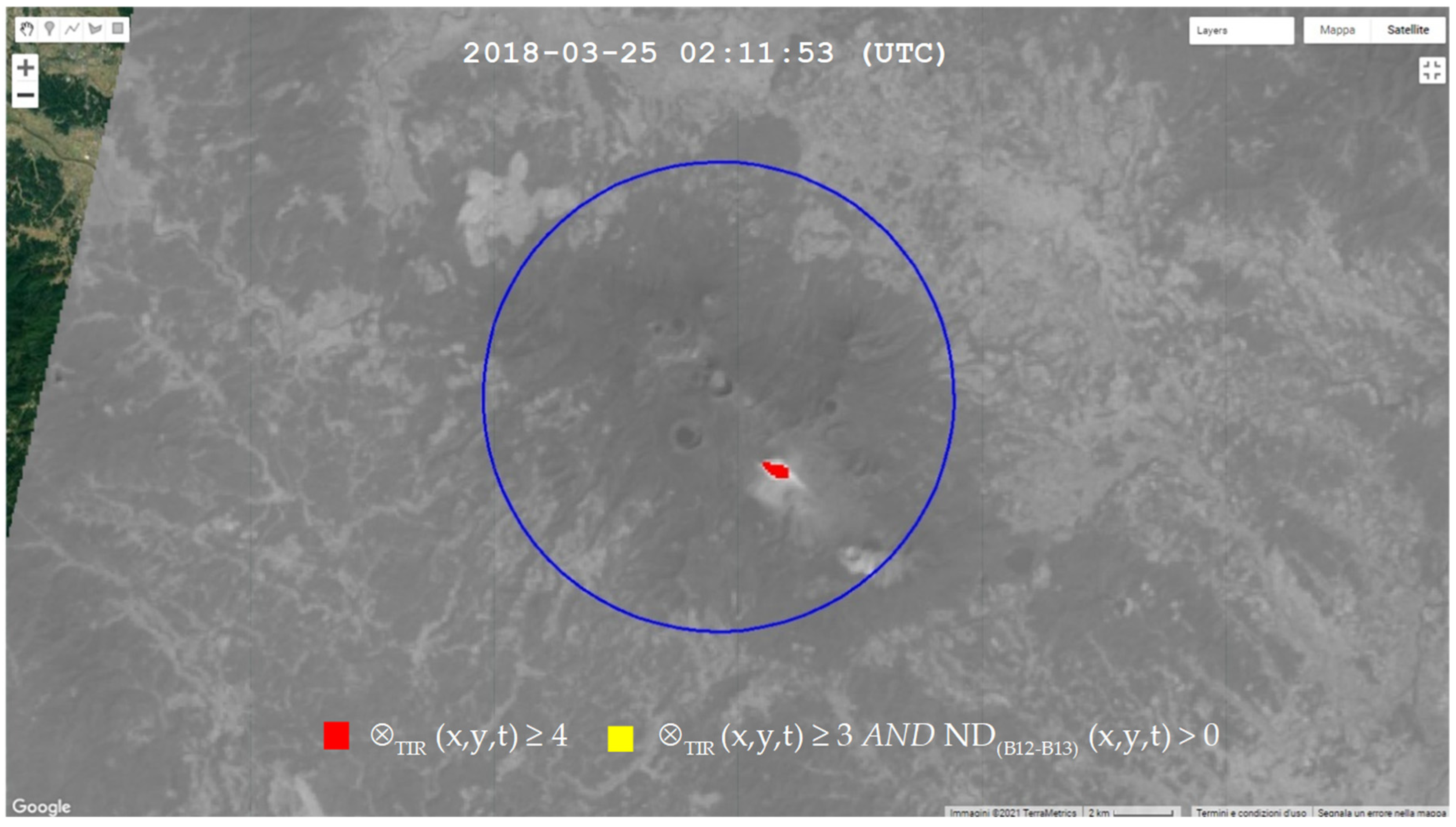
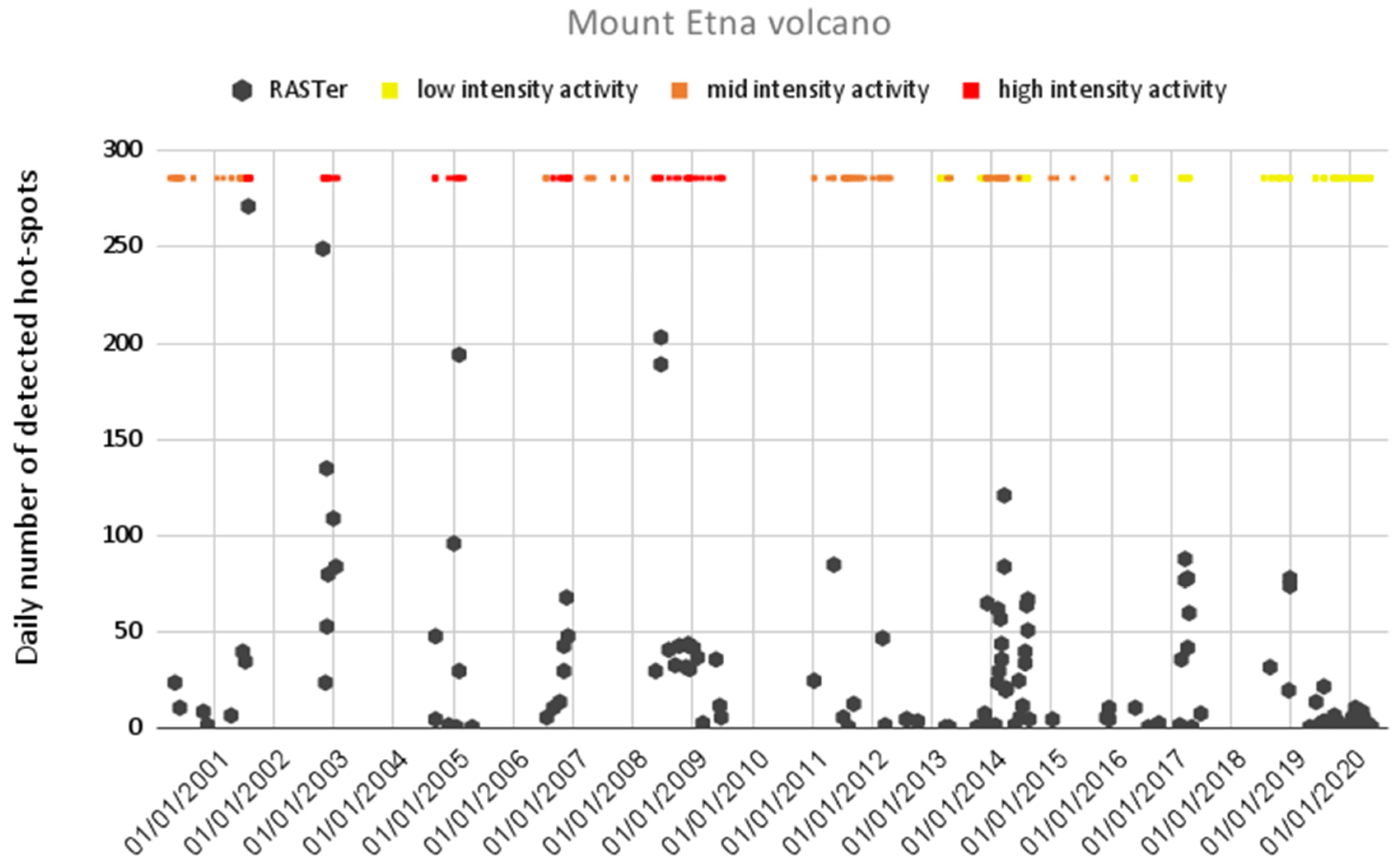
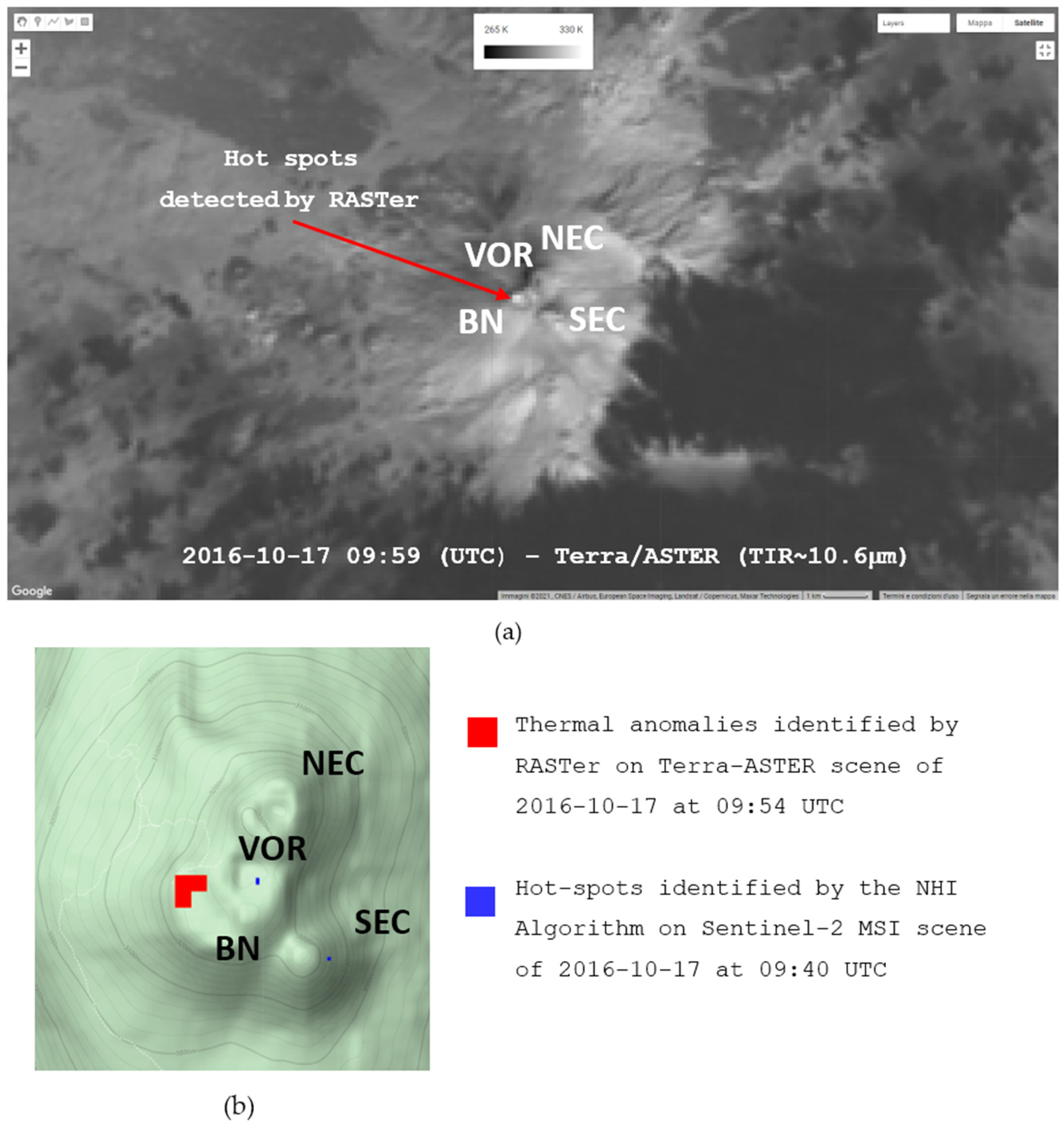
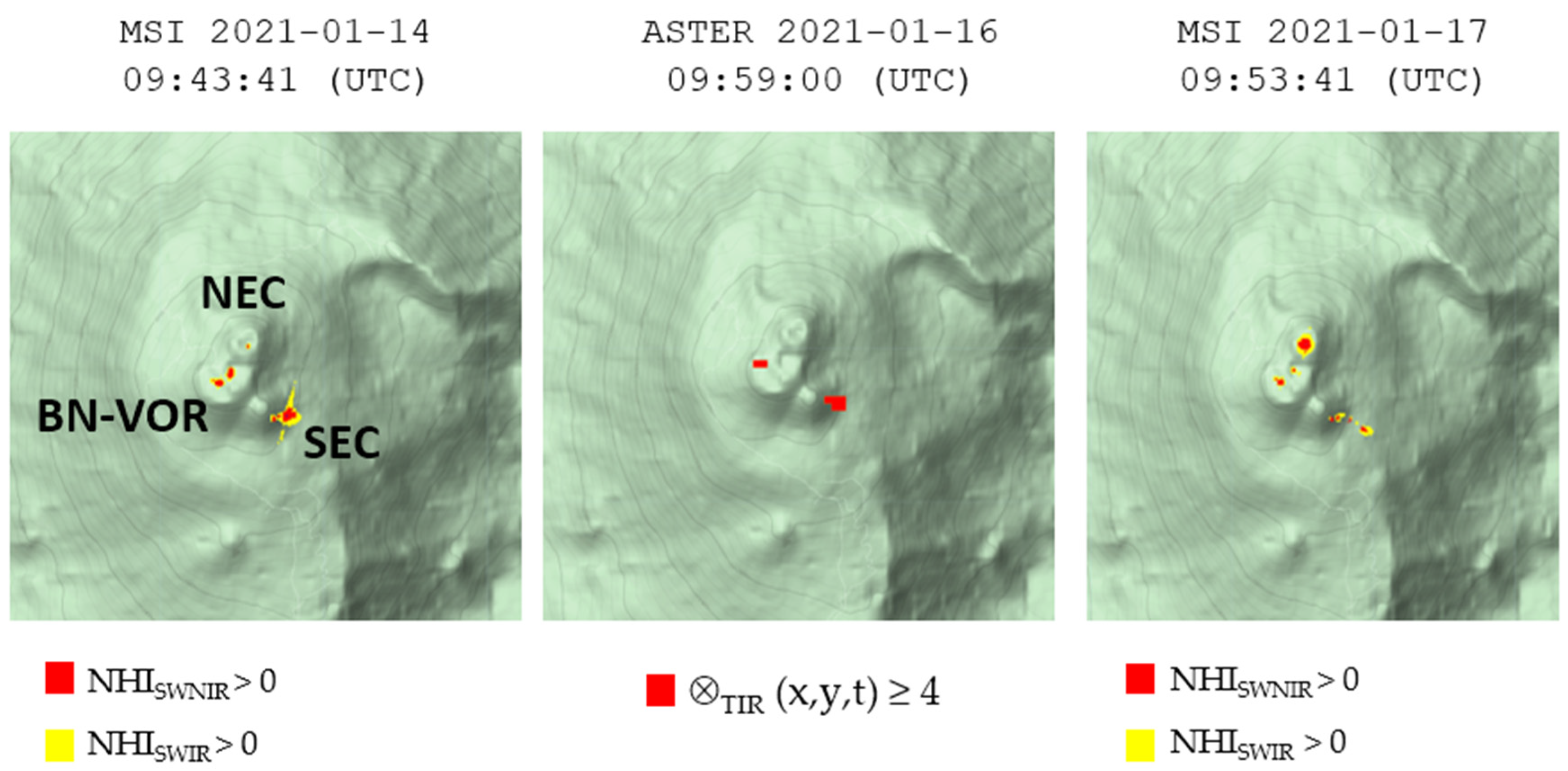
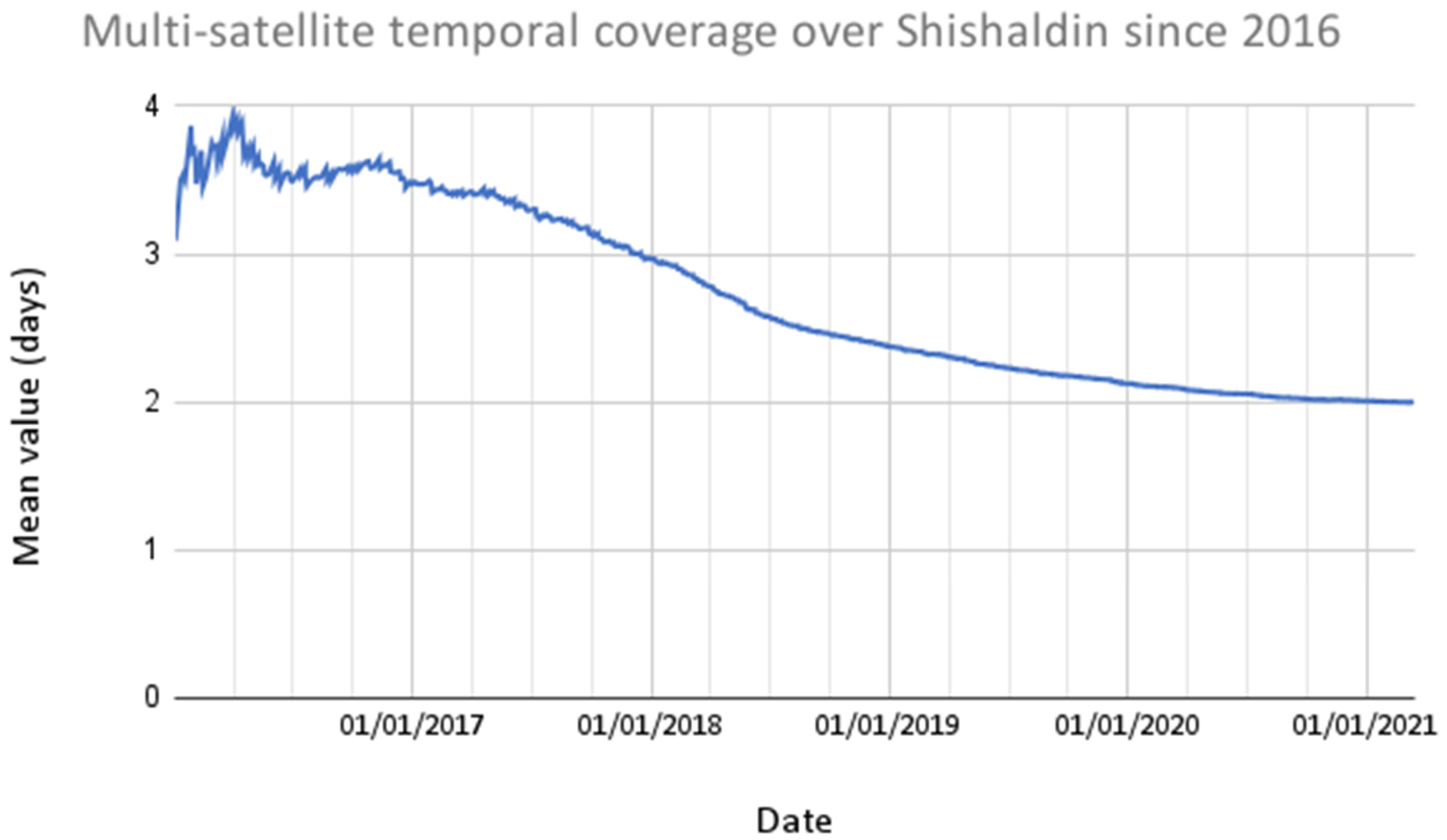
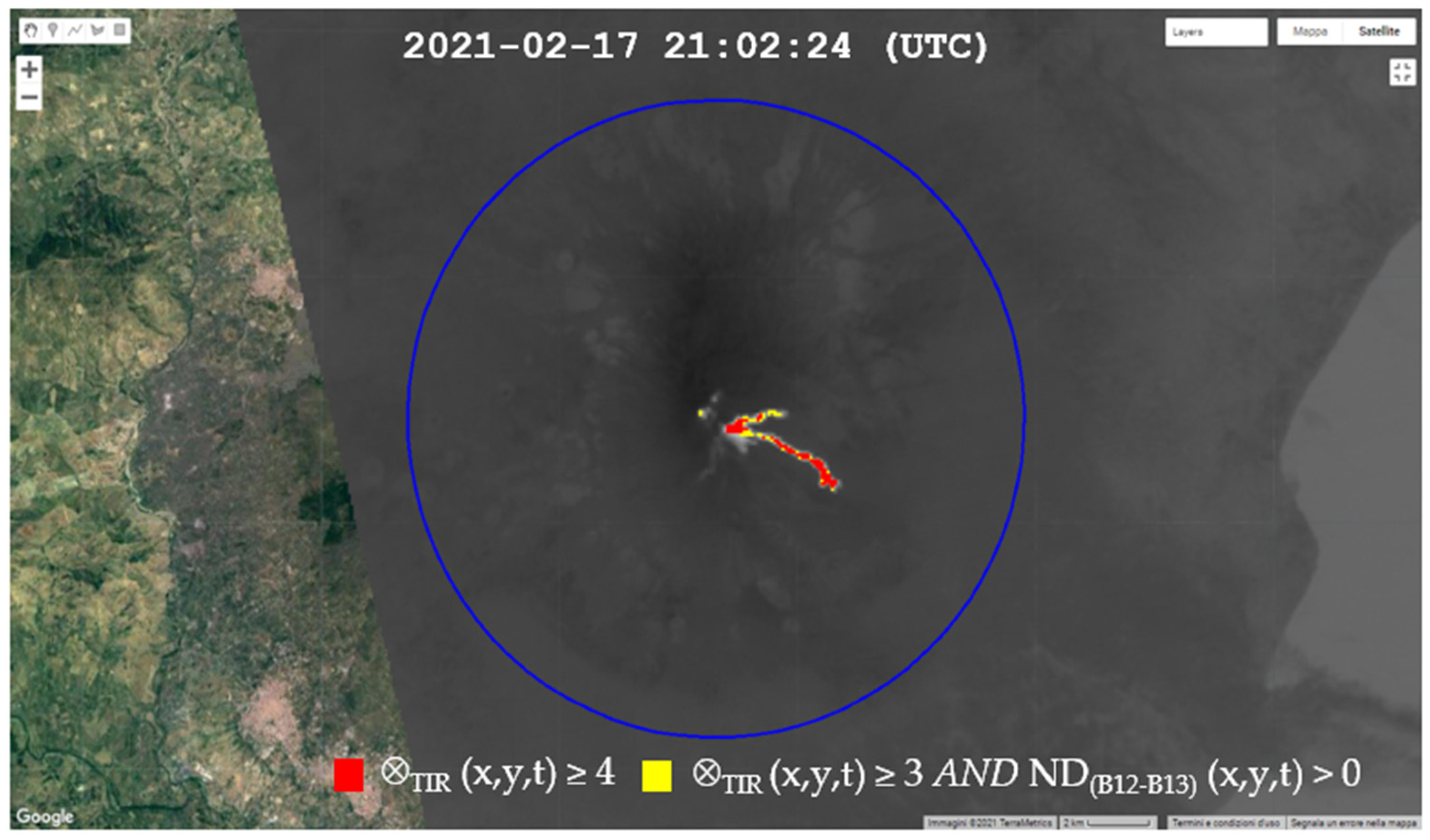
| Name | Resolution | Wavelength |
|---|---|---|
| B01 | 15 m | 0.520–0.600 µm |
| B02 | 15 m | 0.630–0.690 µm |
| B3N | 15 m | 0.780–0.860 µm |
| B04 * | 30 m | 1.600–1.700 µm |
| B05 * | 30 m | 2.145–2.185 µm |
| B06 * | 30 m | 2.185–2.225 µm |
| B07 * | 30 m | 2.235–2.285 µm |
| B08 * | 30 m | 2.295–2.365 µm |
| B09 * | 30 m | 2.360–2.430 µm |
| B10 | 90 m | 8.125–8.475 µm |
| B11 | 90 m | 8.475–8.825 µm |
| B12 | 90 m | 8.925–9.275 µm |
| B13 | 90 m | 10.250–10.950 µm |
| B14 | 90 m | 10.950–11.650 µm |
| Volcano | Number of ASTER Images with Detected Thermal Anomalies (Until August 2017) | Number of Pixels Flagged as Thermal Anomalies | Common Detections | Unique Detections | |||||
|---|---|---|---|---|---|---|---|---|---|
| Number of Scenes | Number of Hot Pixels | Number of Scenes | |||||||
| RASTer (R) | AVA (A) | R | A | R | A | R | A | ||
| Etna | 100 | 100 | 4070 | 3036 | 86 | 3947 | 3017 | 14 | 14 |
| Shinmoedake | 2 | 2 | 60 | 19 | 2 | 60 | 19 | 0 | 0 |
| Shishaldin | 9 | 2 | 26 | 2 | 2 | 8 | 2 | 7 | 0 |
Publisher’s Note: MDPI stays neutral with regard to jurisdictional claims in published maps and institutional affiliations. |
© 2021 by the authors. Licensee MDPI, Basel, Switzerland. This article is an open access article distributed under the terms and conditions of the Creative Commons Attribution (CC BY) license (https://creativecommons.org/licenses/by/4.0/).
Share and Cite
Genzano, N.; Marchese, F.; Neri, M.; Pergola, N.; Tramutoli, V. Implementation of Robust Satellite Techniques for Volcanoes on ASTER Data under the Google Earth Engine Platform. Appl. Sci. 2021, 11, 4201. https://doi.org/10.3390/app11094201
Genzano N, Marchese F, Neri M, Pergola N, Tramutoli V. Implementation of Robust Satellite Techniques for Volcanoes on ASTER Data under the Google Earth Engine Platform. Applied Sciences. 2021; 11(9):4201. https://doi.org/10.3390/app11094201
Chicago/Turabian StyleGenzano, Nicola, Francesco Marchese, Marco Neri, Nicola Pergola, and Valerio Tramutoli. 2021. "Implementation of Robust Satellite Techniques for Volcanoes on ASTER Data under the Google Earth Engine Platform" Applied Sciences 11, no. 9: 4201. https://doi.org/10.3390/app11094201
APA StyleGenzano, N., Marchese, F., Neri, M., Pergola, N., & Tramutoli, V. (2021). Implementation of Robust Satellite Techniques for Volcanoes on ASTER Data under the Google Earth Engine Platform. Applied Sciences, 11(9), 4201. https://doi.org/10.3390/app11094201









